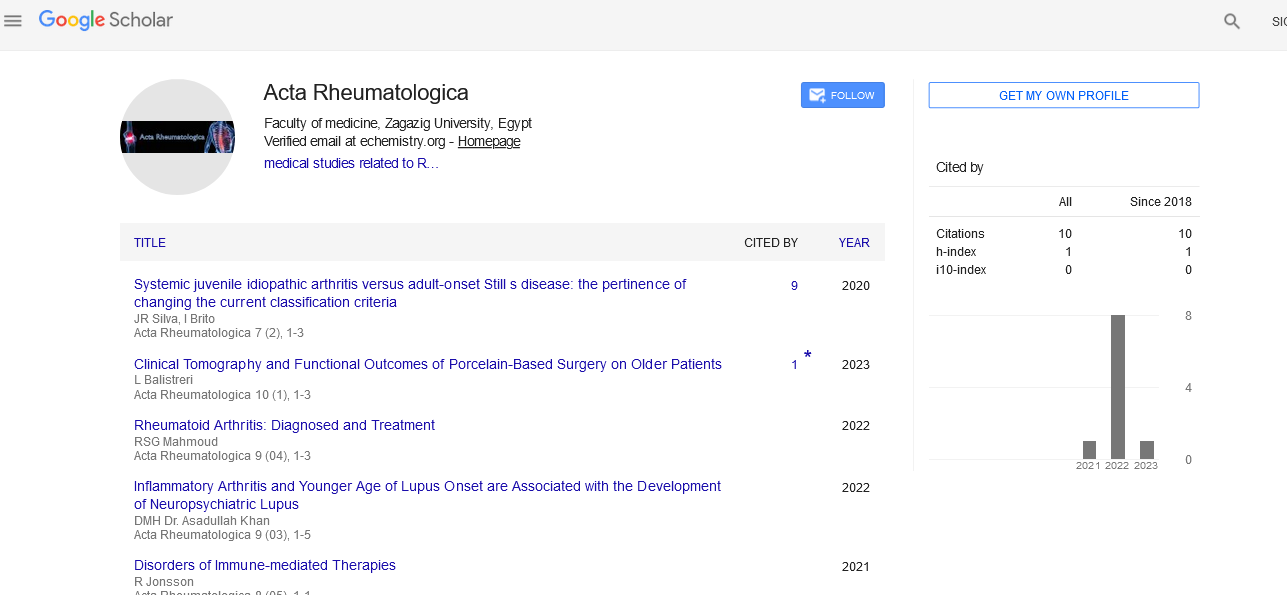Perspective - (2024) Volume 11, Issue 2
Understanding Lupus: Navigating the Complexities of an Autoimmune Disease
Carlo Salvarani*
Department of Orthopedics, University of Turin, Torino TO, Italy
*Correspondence:
Carlo Salvarani, Department of Orthopedics, University of Turin, Torino TO,
Italy,
Email:
Received: 05-Mar-2024, Manuscript No. IPAR-24-14681;
Editor assigned: 08-Mar-2024, Pre QC No. IPAR-24-14681 (PQ);
Reviewed: 22-Mar-2024, QC No. IPAR-24-14681;
Revised: 03-Apr-2024, Manuscript No. IPAR-24-14681 (R);
Published:
11-Mar-2024
Introduction
Lupus, also known as Systemic Lupus Erythematosus (SLE), is a
chronic autoimmune disease that can affect multiple organs and
systems in the body. This complex condition is characterized by
periods of remission and flare-ups, during which the immune
system mistakenly attacks healthy tissues and organs, leading to
inflammation, pain, and damage. In this comprehensive article,
we delve into the intricacies of lupus, exploring its causes,
symptoms, diagnostic approaches, and management strategies
to empower individuals living with this condition and raise
awareness in the broader community.
Description
Unraveling the mysteries of lupus: Causes and
triggers
The exact cause of lupus remains elusive, but researchers
believe that a combination of genetic, environmental, and
hormonal factors contributes to its development. Genetic
predisposition plays a significant role, as individuals with a
family history of lupus are at higher risk of developing the
condition. Environmental triggers such as Ultraviolet (UV) light
exposure, infections, medications, and hormonal changes can
also precipitate lupus flare-ups in susceptible individuals.
Additionally, certain lifestyle factors such as smoking, stress, and
inadequate sleep may exacerbate symptoms and trigger disease
activity in those with lupus.
The spectrum of lupus symptoms: From mild to
severe
Lupus is known for its diverse array of symptoms, which can
vary widely from person to person and fluctuate over time.
Common symptoms of lupus include:
Fatigue: Persistent and overwhelming fatigue is one of the
hallmark symptoms of lupus, often interfering with daily
activities and quality of life.
Joint pain and swelling: Lupus can cause inflammation and
stiffness in the joints, leading to pain, swelling, and decreased
range of motion. Arthritis commonly affects the fingers, wrists,
knees, and ankles in individuals with lupus.
Skin rash: Many individuals with lupus develop a
characteristic butterfly-shaped rash across the cheeks and
bridge of the nose, known as a malar rash. Other skin
manifestations of lupus include photosensitivity, discoid lesions,
and ulcers.
Fever: Low-grade fever or recurrent fevers may occur during
lupus flare-ups, accompanied by malaise, chills, and sweating.
Organ involvement: Lupus can affect virtually any organ or
system in the body, leading to complications such as lupus
nephritis (kidney inflammation), pleurisy (lung inflammation),
pericarditis (heart inflammation), and central nervous system
involvement.
Diagnosing lupus: Navigating the diagnostic maze
Diagnosing lupus can be challenging, as its symptoms mimic
those of other conditions and vary in severity and presentation.
Healthcare providers typically rely on a combination of clinical
evaluation, laboratory tests, and imaging studies to make a
diagnosis. The American College of Rheumatology (ACR) criteria,
updated in 2019, provide guidelines for diagnosing lupus based
on the presence of specific clinical and laboratory features.
These features include skin rashes, oral ulcers, arthritis, kidney
involvement, and abnormalities in blood tests such as
Antinuclear Antibodies (ANA), anti-double-stranded DNA (antidsDNA),
and complement levels.
Managing lupus: A multidisciplinary approach
Treatment for lupus aims to control symptoms, prevent flare-ups,
and minimize organ damage while improving quality of life.
A multidisciplinary approach involving rheumatologists,
dermatologists, nephrologists, and other specialists is often
necessary to address the diverse manifestations of lupus
comprehensively. Treatment strategies may include:
Medications: Nonsteroidal Anti-Inflammatory Drugs (NSAIDs),
antimalarial drugs, corticosteroids, immunosuppressants, and
biologic therapies may be prescribed to reduce inflammation,
manage symptoms, and suppress the immune system.
Lifestyle modifications: Adopting healthy lifestyle habits such
as regular exercise, balanced nutrition, stress management, and
adequate sleep can help individuals with lupus manage their
condition and improve overall well-being.
Sun protection: Because UV light exposure can trigger lupus
flare-ups and exacerbate skin symptoms, individuals with lupus
are advised to practice sun protection measures, including
wearing sunscreen, protective clothing, and avoiding midday sun
exposure.
Regular monitoring: Regular follow-up visits with healthcare
providers are essential for monitoring disease activity, assessing
organ function, and adjusting treatment as needed to achieve
optimal disease control.
Conclusion
Living with lupus can be challenging, but with the right
support, resources, and management strategies, individuals can
lead fulfilling and meaningful lives despite the challenges posed
by the condition.
Support groups, patient education programs, and online
resources provide valuable information, practical tips, and
emotional support for individuals with lupus and their families.
By raising awareness, advocating for research, and
promoting early diagnosis and intervention, we can improve
outcomes and quality of life for those affected by lupus and
work towards a future free from the burden of this complex
autoimmune disease.
Citation: Salvarani C (2024) Understanding Lupus: Navigating the Complexities of an Autoimmune Disease. Acta Rheuma Vol:11 No:2





